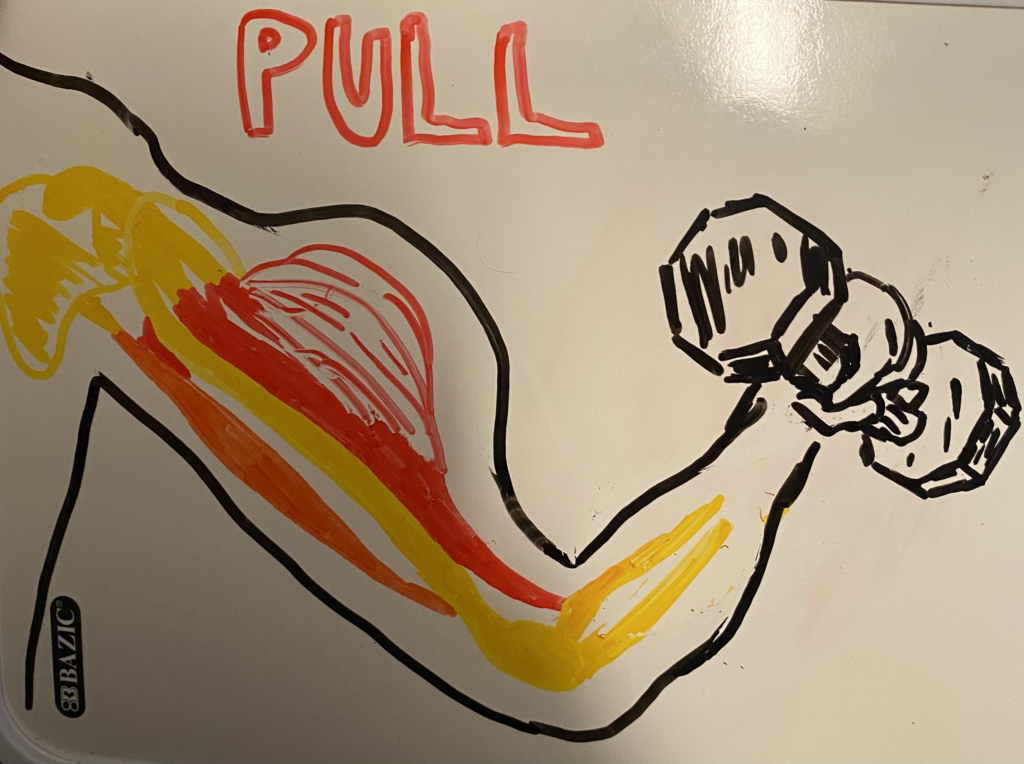For my Steam project, I decided to research bicep tears. I was interested finding out the different way biceps can be torn. After my dad tore both of his bicep muscles, his right arm bicep while working out, and his left arm while playing volleyball. For the bicep he tore while working out, he did not require surgery, yet for the one he tore while playing volleyball he had to get an operation done on it to fix it. So I became interested in the specifics of why he didn’t need surgery for one.
The most common way a bicep can tear is during contraction while holding a load that the arm isn’t used to holding.
There are three classifications of bicep “tears”.
-Pull
-Sprain
-Tear
The muscle fibers inside the skeletal bicep muscle are the
actual things that “tear”. When the bicep is overexerted by lifting a large amount of weight, it can either
partially or fully tear. A partial tear is categorized as a pull or a sprain. This is when the muscle fibers tear,
but not all of them completely. When it fully tears, the muscle fibers no longer connect and are torn
somewhere in the bicep muscle apart from each other.
The bicep is a skeletal muscle, which means it is attached to a bone. The cells inside skeletal
muscle are long and cylindrical and have multiple nuclei. There are also striations in the muscle, which
are sometimes visible in humans muscles when the human is very lean. The purpose of the bicep muscle
is to contract and extend, or flex and supinate. Now, when someone works out their bicep, they are
contracting the muscle fibers. The growth actually happens after the workout. The body undergoes a
cellular process that repairs the muscle fibers that were damaged during the workout by fusing muscle
fibers together which form more protein strands and myofibrils. The new myofibrils are thicker and more
abundant which causes the growth, or the muscle getting bigger.
The body is good at repairing itself from these injuries, but when the bicep fully tears, a surgery is often required and the recovery time is much longer. In order to prevent these injuries, stretch and keep the muscles active. These can prevent a bicep tear from occurring at all.
Citations:
Azzopardi, Christine, et al. “Isolated Complete Distal Biceps Femoris Tendon Tears: Case Series and
Literature Review.” Indian Journal of Radiology and Imaging, Thieme Medical and Scientific
Publishers Pvt. Ltd., 10 Jan. 2022,
https://www.thieme-connect.de/products/ejournals/html/10.1055/s-0041-1741106.
Mandeep S. Virk MD, Jessica Diverne BS, Augustus D. Mazzocca MS.al. “Distal Biceps Tendon
Injuries: Treatment of Partial and Complete Tears.” Operative
Techniques in Sports Medicine, W.B. Saunders, 11 June 2014,
https://www.sciencedirect.com/science/article/abs/pii/S1060187214000215.
Yuki Shibayama MD.“Diagnostic Accuracy of Magnetic Resonance Imaging for Partial Tears of the
Long Head of the Biceps Tendon in Patients with
Rotator Cuff Tears.” JSES International, Elsevier, 4 Apr. 2022,
https://www.sciencedirect.com/science/article/pii/S2666638322000767.




Dean, this was as interesting project as it actually does resonate with me. My husband had torn his bicep muscle working out as well at the beginning of September. His left arm is still not all the way healed but is still much better than when he first got hurt. He can barely do a bicep curl with a 20lb weight, which frustrates him to no end, but getting it back to full strength will undoubtedly take time.
Your project has taught me a couple of new things I was not aware of, and it did make me do a little research as well because it was interesting. The three classifications of tears: pull and sprain which are partial, and a full tear where the muscle fibers are fully separated. So these kinds of tears are classified as injuries. What I found more interesting was what you had written about how the muscle is grown from exercise. So, during the workout of the muscle, there is also tearing that happens, but these tears are microtears (I just learned this term). After working out, during recovery is where the growth happens. You explained it quite well, how there is a cellular process that muscles fibers go through to repair the damages (microtears). The muscle fibers fuse together and form more protein strands and myofibrils which are more abundant and thicker, which in turn is stronger and bigger muscles. I found that very interesting, as I have always known that working out creates muscles, but never exactly how. Great project!